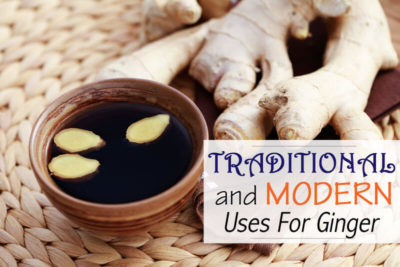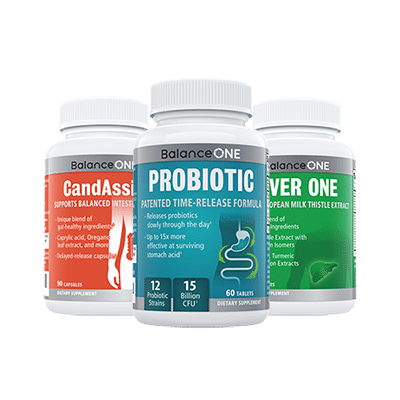How Ginger Is Used In Traditional & Modern Medicine

Ginger has so many uses that I thought I would devote a blog post to listing them. In addition to its properties as an antifungal, ginger has been shown to be effective against osteoarthritis, motion sickness and morning sickness.
It has long been used to improve digestion, treat nausea, and reduce the inflammation that can be associated with a Candida overgrowth.
Ginger contains antifungal ingredients too, including gingerol and shagelol. Studies have shown that these compounds can inhibit the growth of Candida albicans.
Let’s learn some more about this incredible natural remedy!
Ginger is not actually a plant, but rather the root, more specifically the rhizome, of another plant named Zingiber officinale. It is native to Asia where evidence suggests that it has been in use, both for medicinal and cooking purposes, for over 4,000 years. It is a beige-colored stem that sticks up about 12 inches above ground, and it has a long and narrow green leaves with white and yellow flowers.
The active ingredients in ginger, those which give it its medicinal properties, are volatile oils which can represent anywhere from 1% to 3% of the entire weight of the root. Among these active ingredients are shogaols and gingerols.
Table Of Contents
Traditional Uses For Ginger
Ever since its discovery, ginger has proven to be very useful to Asian and Arabic cultures. It is an ingredient in countless recipes, but has also been used for centuries for its medicinal and antifungal properties.
In various cultures, ginger has been used to treat common ailments such as headaches, nausea, vomiting, indigestion, flu, diarrhea, arthritis, colic, and even painful menstruation.
These medicinal properties have often been exploited through the use of ginger-based drinks. For example, tea made with ginger root is a common, traditional remedy for a cold, while ginger beer and ginger ale are still drunk to help ease indigestion.
In Burma, ginger is mixed with another local plant and consumed as a preventative measure against the flu.
People in India make a paste out of ginger and apply it to their temples to treat a headache. They also eat it to treat a common cold, and mix it with salt and lemon to use against nausea.
Elsewhere in Asia, ginger is used by Indonesians in a number of remedies designed to treat rheumatism and fatigue, and control poor eating habits.
People in the Congo make a juice from ginger mixed with sap from a mango tree and use it to treat a wide variety of conditions. In Nepal, people often use ginger to reduce the symptoms of a cold.
No other country has been more prolific in herbal remedies than China. Here, a simple drink made by mixing ginger in water with brown sugar is used to relieve the symptoms of the common cold. A special omelet made of scrambled eggs and diced ginger root is consumed to treat coughing.
A type of dried candy is made using ginger fermented in plum juice, which was also used to treat coughing. Lastly, ginger is also used by the Chinese to treat inflammation and arthritis. Ginger is a safe option to add to your list of anti-Candida foods and integrate into your diet.
Ginger In Medical Research
Ginger has been shown to have several medicinal benefits, although more research is needed in many of these areas. As with many other natural remedies that pharmaceutical companies are unable to patent, there has simply not been enough funding devoted to research on ginger.
This means many of the research studies available are from Asian universities, smaller, and sometimes poorly designed.
Osteoarthritis
In a 2001 double-blind, placebo-controlled study, researchers examined 261 patients who all had osteoarthritis of the knee. (1) They found that the patients who took ginger regularly experienced significantly less knee pain after 6 weeks. The only side effects exhibited were minor stomach upsets.
Another studies have found that ginger can reduce inflammation in the colon, as well as in various arthritic and musculoskeletal conditions. One recent in vitro study, on cells from patients with rheumatoid arthritis or osteoarthritis, found that ginger extract reduced the production of pro-inflammatory cytokines. (2) In fact, it had a similar effect to that of betamethasone, an anti-inflammatory steroid medication.
Motion sickness
There is research to suggest that ginger is effective at dealing with nausea such as that brought on by motion sickness. One such study, looking specifically at seasickness found that eating 1g of ginger “reduced the tendency to vomiting and cold sweating” among naval cadets. (3)
So give ginger a try to combat motion sickness on boats, planes and in cars. So give ginger a try to combat motion sickness on boats, planes and in cars. Ideally it should be taken 1-2 hours before traveling and every 2-4 hours while traveling.
Morning sickness
Multiple studies among pregnant women have highlighted the potential for ginger to be used for morning sickness. (4) In general, studies have shown a decrease in nausea and instances of vomiting among women who took ginger, as opposed to those who took the placebo. However, it should be noted there is some evidence that ginger may be mutagenic, so it should be used with caution, for no more than a few days in a row, and preferably under the supervision of your healthcare professional.
Since ginger is effective at relieving nausea, it was hoped that it could also be used as a preventative measure to reduce nausea experienced after surgery and other medical procedures. However, in this instance, ginger proved to be no more effective than a placebo.
Future Uses For Ginger
Most of the research into ginger over the past few decades has focused on its anti-inflammatory properties and its ability to reduce nausea. These have been confirmed by various research studies into inflammatory conditions like arthritis, and nausea-related conditions like motion sickness and morning sickness.
Ginger has been categorized as “generally recognized as safe” by the FDA and is commonly used for the conditions listed above. However, other research studies have suggested that there may be wider uses for ginger.
Several traditional uses for ginger are still being tested, as some of them have shown promising initial results. For example, some cultures have used ginger as preventive medication against heart disease, and preliminary studies suggest that this might indeed be the case.
It is possible that ginger might lower cholesterol and prevent blood from clotting. This would, in turn, prevent blood vessels from getting blocked and significantly reduce the chances of a stroke or a heart attack. Even so, more research is necessary in order to determine if ginger is effective or safe for people with heart disease.
References and Further Reading
1. Altman et al (2001), “Effects of a ginger extract on knee pain in patients with osteoarthritis”, http://onlinelibrary.wiley.com/doi/10.1002/1529-0131(200111)44:11%3C2531::AID-ART433%3E3.0.CO;2-J/full
2. Ribel-Madsen et al (2012), “A Synoviocyte Model for Osteoarthritis and Rheumatoid Arthritis: Response to Ibuprofen, Betamethasone, and Ginger Extract—A Cross-Sectional In Vitro Study”, http://www.hindawi.com/journals/arthritis/2012/505842/.
3. Grontved et al (1988), “Ginger root against seasickness. A controlled trial on the open sea.”, http://www.ncbi.nlm.nih.gov/pubmed/3277342.
4. Vutyanavich et al (2001), “Ginger for Nausea and Vomiting in Pregnancy: Randomized, Double‐Masked, Placebo‐Controlled Trial”, http://journals.lww.com/greenjournal/pages/articleviewer.aspx?year=2001&issue=04000&article=00017&type=Fulltext.

3-Month Candida Elimination Kit Start Your 3-month Candida Cleanse
This Candida Kit contains all the supplements recommended on the Candida Diet:
- LIVER ONE to process and remove the toxins created by Candida.
- CANDASSIST to inhibit and weaken the Candida colonies in your gut.
- PROBIOTIC to replace the Candida yeast with probiotic bacteria.
Plus... the CANDIDA DIET RECIPE BOOK with 50+ low-sugar recipes


Ginger juice and tea have been the one reliable treatment to ease my brain fog for me these past three months struggling with candida. I can’t get enough!
I have used ginger for several ailments since I was a child.